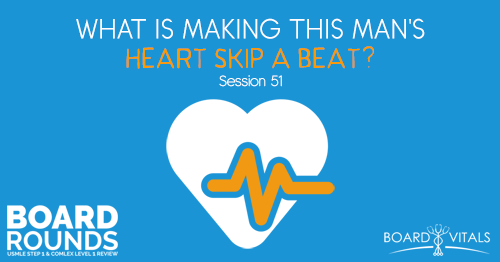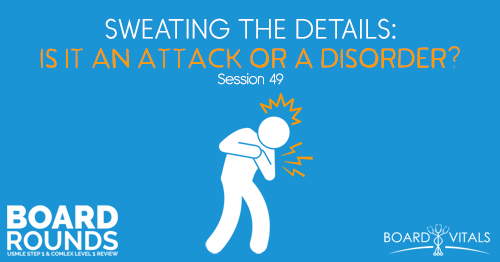[smart_track_player url=”http://traffic.libsyn.com/boardroundsone/BR6.mp3″ color=”004075″ title=”USMLE and COMLEX Prep: 60 y/o Male with a Murmur” ]

Session 06
Today, we start our board content. We thought that there is no better way to start than with the heart.
As always, I’m joined by Dr. Andrea Paul from Board Vitals, a company that helps you with your board prep. They feature an amazing QBank and software platform to help you maximize your score. Save 15% off any of their QBank packages by using the promo code BOARDROUNDS at checkout.
[03:11] Scenario of a Heart Murmur in a 60-Year-Old Male
Case: A 60-year-old male is undergoing evaluation for a heart murmur. He’s asymptomatic and his physician discovers a holosystolic murmur at the cardiac apex. The frequency of that murmur is increased when he expires and an echo confirms that there’s a diagnosis to be found.
Question: Compared to a normal patient, which of the following hemodynamic changes would be most likely present?
Note: This involves multi-steps where you have to figure out from the murmur and it’s confirming there is something so you could look at the murmur and decide what you think the diagnosis is. From there, you go one step further and say what physiologic effect that would have.
[04:10] Knowing the Types of Murmur
First, you have to know the types of murmurs out there. Holosystolic means that the murmur is present during the entire systole phase. There are some that fade off before the end or would just be a click sound at the beginning of systole.
Holocystolic refers to the sound that is present the entire time. It can be one consistent sound for all systole or maybe it’s something that starts at an increased volume or decreases. So you’re left with different options.
In this case, it says it’s in the cardiac apex. You have to look at other components like the student’s age to determine what exactly is causing the murmur. But here we’re lucky since they’re telling us here that it’s right in the apex.
[06:35] Mitral Valve Regurgitation
When you’re hearing this whole systolic murmur at the cardiac apex, you immediately start to think of mitral valve. When you look at the diagram, you will find different areas where you can picture where the apex of the heart is and what would be causing a sound in that direction. If you’re visual, you can picture the mitral valve in the direction of the flow. If it weren’t functioning properly, it would be right to the apex of the heart. So this would lead you to suspect mitral valve regurgitation.
Another thing you can think of is mitral stenosis, however, that’s diastolic so it would be heard in a similar area at a different time.
Other things to think of when you have mitral valve regurgitation is that it kind of fits with the patient. If the question had said something about an irregular pulse or displaced apex, that would be the first thing that would fit with mitral valve regurgitation as well.
Although the patient here is asymptomatic, common symptoms would be rhematic fever, palpitation, fatigue, shortness of breath, and it can go as far as having signs of heart failure. So any of those components in any combination could be present in the question that would lead to the same answer in the end.
[09:25] Answer Choices
A Increased after load
B Decreased pre-load
C Increased ejection fraction
D Decreased ejection fraction
E Decreased contractility
Now, you have to understand what all of those components mean. In most cases, mitral valve regurgitation would be easily heard during expiration. This specific murmur isn’t one that is always so strongly correlated. But this is something to keep in mind that expiration is more positive pressure down on the heart, more pressure on the ventricle and potentially easier to have a bit more of regurgitation.
[11:11] Understanding the Terms: Afterload
Afterload is the pressure against which the heart is working to eject the blood during systole. It’s a systolic murmur so this is the one we’re hearing here. And it’s the component where the answer option is asking whether there would be increased afterload. In this case, that would not be correct since we’re having regurgitation. Afterload does have an effect on the stress volume because the maximum pressure of the heart that can develop becomes smaller when there’s volume inside the ventricle.
During the systolic phase of the heart, this afterload is the pressure that’s coming on the blood way out of the heart. As you’re contracting, that mitral valve cannot hold itself shut. And you’re having that regurgitation coming back in the opposite direction.
[13:04] Understanding the Terms: Afterload and Ejection Fraction
The preload is the filling pressure of the heart at the end of diastole. Once it’s filled, the left atrial pressure at the end of diastole. We imagine Starling’s Law which states that the heart is going to eject to a greater volume if it’s filled to a greater volume at the end of diastole. That relationship can be modified by contractility in the afterload that would affect what ends up resulting.
Ejection fraction is just the percentage of the blood left in the ventricle after a contraction. So if you have systole, the ventricles contract. 50% remains and that’s the ejection fraction.
[14:30] Causing Ejection Fraction
After you’ve determined that it’s mitral valve regurgitation, you can look at the electrocardiogram. We have shown that since the patient has no symptoms, probably compensating for this is a chronic disease that’s why he’s not coming in with any specific symptoms other than the murmur heard. Most likely, he has dilated his left atrium or left ventricle to compensate. Most patients with chronic mitral valve regurgitation have that.
Then you have this retrograde flow happening over that mitral valve. So you would probably see a slight decrease in his afterload because of the resistance across that valve. The most likely though is you would see increased ejection fraction.
[16:20] Starling’s Law
Think of the volume of the heart at the end of the diastole phase. That’s going to give you a filling pressure, which is the preload. You would see that if you have that increased volume and pressure of blood in there to start with, that’s going to lead to increased volume in systole and it affects contractility and afterload. But it’s just sort of a volume and pressure play and less to do with the actual muscle fibers.
If you look overall the spectrum of clinical cases, you can see mostly that it all comes down to volume and pressure.
[17:45] More Options to Think Through
This question is great because it brings up not just all the different types of murmurs that you have to run through but it also gives you all those different scenarios to think through for all the different murmurs. So you would have to go through all these options and assess each.
If you just think through where is blood flowing during what phase of the cardiac cycle, you can almost figure out which answer you can immediately eliminate. This is the nice thing about cardiac physiology is that once you can think through oeach of the different causes of the murmur and think about afterload and preload and each one, it’s something you probably won’t forget because you’ve made sense of it, and not just memorized it.
[19:55] Some Tips to Help You Study Effectively
There are mnemonics you can use for the different types of murmurs so it’s easier for you, like to know which sound and during which phase can lead to whether mitral stenosis or mitral valve regurgitation or aortic regurgitation. So if you’re someone who can easily figure out how to memorize this then this is something you can jot down for sure.
Moreover, rheumatic fever can also be something to consider that can cause aortic stenosis as well. If you know the basics and you know how to recognize mitral regurgitation and understand the physiology behind it, then you’ll be able to lead yourself to any of those types of questions.
Again, understand the causes of any of these murmurs. Know the signs. For instance, in aortic stenosis, that slow rising pulse is going to be in the question almost definitely, since that’s one of those really unique cardinal signs of aortic stenosis, or the opposite is the collapsing pulse in aortic regurgitation. Knowing some of those clinical signs is super helpful in these types of questions.
Links:
Board Vitals (Save 15% off any of their QBank packages by using the promo code BOARDROUNDS at checkout.)
Listen to Other Episodes
[smart_podcast_player url=”http://medicalschoolhq.libsyn.com/rss” color=”004075″ show_name=”The Premed Years” ]
SEARCH SITE
LISTEN FOR FREE











